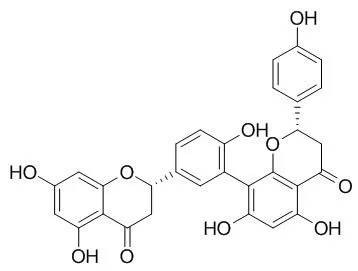| Description: |
Tetrahydroamentoflavone is a potent XO inhibitor, may be considered as a drug candidate or chemopreventive agent; it has anti-inflammatory effects, it shows in vitro cyclooxygenase (COX) inhibition activity ( an IC(50) value of 29.5 microM (COX-1) and 40.5% inhibition at 100 microg/mL (COX-2)). (2S,2″S )-Tetrahydroamentoflavone exerts its antioxidant activity in vitro through metal-chelating, and radical-scavenging, which is via donating a hydrogen atom (H61) and an electron (e). |
| In vitro: |
| J Ethnopharmacol. 2011 Feb 16;133(3):1117-20. | | Tetrahydroamentoflavone (THA) from Semecarpus anacardium as a potent inhibitor of xanthine oxidase.[Pubmed: 20965242] | Seed of Semecarpus anacardium L. is widely used in Indian traditional medicine; Ayurveda and Sidha, for treatment of inflammatory disorders and gout.
The present study was aimed at isolation of a compound for its potential to inhibit xanthine oxidase (XO), over expression of which lead to inflammation and gout.
METHODS AND RESULTS:
Activity guided fractionation of S. anacardium seed was conducted using liquid-liquid partition and preparative HPLC. The fractions were evaluated for their XO inhibition and antioxidant activity. The ethyl acetate fraction with the highest XO activity yielded a biflavonoid compound Tetrahydroamentoflavone (THA). Lineweaver-Burk (LB) plot for the XO inhibition of THA and allopurinol was constructed from the kinetic data.
IC₅₀ values of THA and allopurinol for XO inhibition were 92 and 100 nM respectively and their corresponding values for K(i) were 0.982 and 0.612 μM respectively.
CONCLUSIONS:
THA was a potent XO inhibitor which could be considered as a drug candidate or chemopreventive agent, after establishing its pharmacological and clinical evaluation. The study results appear to support the claim of the traditional medicine with respect to the efficacy of S. anacardium seed against inflammation and gout. | | Natural Product Communications, 2013 ,8 (6) :787-9. | | Antioxidant Activity and Mechanism of Tetrahydroamentoflavone in vitro[Reference: WebLink] |
(2S,2″S )-Tetrahydroamentoflavone (THA) is a typical biflavonoid.
METHODS AND RESULTS:
In this study, we systematically evaluated its antioxidant activity by various antioxidant assays in vitro. The IC50 values of THA were 4.8±0.3, 743.2±49.5, 35.5±1.9, 165.7±22.8, 4.4±0.2, and 77.1±2.2 μg/mL, respectively, for superoxide (61O2-) radical-scavenging, Fe2+-chelating, Cu2+-chelating, DPPH61 (1,1-diphenyl-2-picrylhydrazyl radical) scavenging, ABTS61+ (3-ethylbenzthiazoline-6-sulfonic acid radical) scavenging, and Cu2+-reducing power. The average ratio value of IC50,Trolox:IC50,THA was calculated as 2.54, suggesting that THA possesses 2.54 times the total antioxidant level than the standard antioxidant Trolox.
CONCLUSIONS:
THA exerts its antioxidant activity in vitro through metal-chelating, and radical-scavenging, which is via donating a hydrogen atom (H61) and an electron (e). Its antioxidant activity can be responsible for its pharmacological effect and make it an attractive natural antioxidant. | | J Ethnopharmacol. 2004 Dec;95(2-3):209-12. | | A cyclooxygenase (COX) inhibitory biflavonoid from the seeds of Semecarpus anacardium.[Pubmed: 15507338 ] | Semecarpus anacardium Linn., Anacardiaceae, is being most commonly used in India for the treatment of rheumatoid arthritis and other inflammatory disorders.
METHODS AND RESULTS:
Bioactivity guided fractionation of ethyl acetate extract led to the isolation of major active principle, Tetrahydroamentoflavone (THA), a biflavonoid. The in vitro cyclooxygenase (COX-1) catalyzed prostaglandin biosynthesis assay of THA gave an IC(50) value of 29.5 microM (COX-1) and 40.5% inhibition at 100 microg/mL (COX-2).
The in vivo carrageenan induced paw edema assay resulted in dose dependent anti-inflammatory effect of THA and the activity was comparable to that of ibuprofen, one of the well known NSAIDs. |
|






 Cell. 2018 Jan 11;172(1-2):249-261.e12. doi: 10.1016/j.cell.2017.12.019.IF=36.216(2019)
Cell. 2018 Jan 11;172(1-2):249-261.e12. doi: 10.1016/j.cell.2017.12.019.IF=36.216(2019) Cell Metab. 2020 Mar 3;31(3):534-548.e5. doi: 10.1016/j.cmet.2020.01.002.IF=22.415(2019)
Cell Metab. 2020 Mar 3;31(3):534-548.e5. doi: 10.1016/j.cmet.2020.01.002.IF=22.415(2019) Mol Cell. 2017 Nov 16;68(4):673-685.e6. doi: 10.1016/j.molcel.2017.10.022.IF=14.548(2019)
Mol Cell. 2017 Nov 16;68(4):673-685.e6. doi: 10.1016/j.molcel.2017.10.022.IF=14.548(2019)